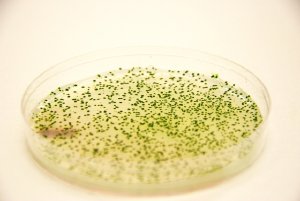Dec 11 2009
The genetically modified cyanobacterium consumes carbon dioxide and produces the liquid fuel isobutanol by using energy from sunlight.
 Genetically engineered strains of the cyanobacterium Synechococcus elongatus in a Petri dish
Genetically engineered strains of the cyanobacterium Synechococcus elongatus in a Petri dish
Global climate change has prompted efforts to drastically reduce emissions of carbon dioxide, a greenhouse gas produced by burning fossil fuels.
In a new approach, researchers from the UCLA Henry Samueli School of Engineering and Applied Science have genetically modified a cyanobacterium to consume carbon dioxide and produce the liquid fuel isobutanol, which holds great potential as a gasoline alternative. The reaction is powered directly by energy from sunlight, through photosynthesis.
The research appears in the Dec. 9 print edition of the journal Nature Biotechnology and is available online.
This new method has two advantages for the long-term, global-scale goal of achieving a cleaner and greener energy economy, the researchers say. First, it recycles carbon dioxide, reducing greenhouse gas emissions resulting from the burning of fossil fuels. Second, it uses solar energy to convert the carbon dioxide into a liquid fuel that can be used in the existing energy infrastructure, including in most automobiles.
While other alternatives to gasoline include deriving biofuels from plants or from algae, both of these processes require several intermediate steps before refinement into usable fuels.
"This new approach avoids the need for biomass deconstruction, either in the case of cellulosic biomass or algal biomass, which is a major economic barrier for biofuel production," said team leader James C. Liao, Chancellor's Professor of Chemical and Biomolecular Engineering at UCLA and associate director of the UCLA-Department of Energy Institute for Genomics and Proteomics. "Therefore, this is potentially much more efficient and less expensive than the current approach."
Using the cyanobacterium Synechoccus elongatus, researchers first genetically increased the quantity of the carbon dioxide-fixing enzyme RuBisCO. Then they spliced genes from other microorganisms to engineer a strain that intakes carbon dioxide and sunlight and produces isobutyraldehyde gas. The low boiling point and high vapor pressure of the gas allows it to easily be stripped from the system.
The engineered bacteria can produce isobutanol directly, but researchers say it is currently easier to use an existing and relatively inexpensive chemical catalysis process to convert isobutyraldehyde gas to isobutanol, as well as other useful petroleum-based products.
In addition to Liao, the research team included lead author Shota Atsumi, a former UCLA postdoctoral scholar now on the UC Davis faculty, and UCLA postdoctoral scholar Wendy Higashide.
An ideal place for this system would be next to existing power plants that emit carbon dioxide, the researchers say, potentially allowing the greenhouse gas to be captured and directly recycled into liquid fuel.
"We are continuing to improve the rate and yield of the production," Liao said. "Other obstacles include the efficiency of light distribution and reduction of bioreactor cost. We are working on solutions to these problems."